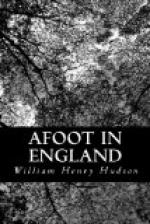Then I left him and thought no more about the crows except that their young have a good deal to learn upon first coming forth into an unfriendly world. But there was a second nest and family close by all the time. A day or two later I discovered it accidentally in a very curious way.
There was one spot where I was accustomed to linger for a few minutes, sometimes for half an hour or so, during my daily walks. Here at the foot of the low bank on the treeless side of the stream there was a scanty patch of sedges, a most exposed and unsuitable place for any bird to breed in, yet a venturesome moorhen had her nest there and was now sitting on seven eggs. First I would take a peep at the eggs, for the bird always quitted the nest on my approach; then I would gaze into the dense tangle of tree, bramble, and ivy springing out of the mass ’of black rock and red clay of the opposite bank. In the centre of this rough tangle which overhung the stream there grew an old stunted and crooked fir tree with its tufted top so shut out from the light by the branches and foliage round it that it looked almost black. One evening I sat down on the green bank opposite this tangle when the low sun behind me shone level into the mass of rock and rough boles and branches, and fixing my eyes on the black centre of the mass I encountered a pair of crimson eyes staring back into mine. A level ray of light had lit up that spot which I had always seen in deep shadow, revealing its secret. After gazing steadily for some time I made out a crow’s nest in the dwarf pine top and the vague black forms of three young fully fledged crows sitting or standing in it. The middle bird had the shining crimson eyes; but in a few moments the illusory colour was gone and the eyes were black.




